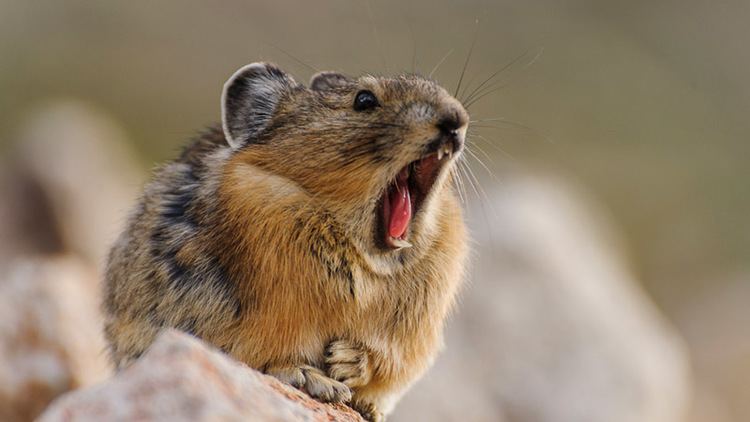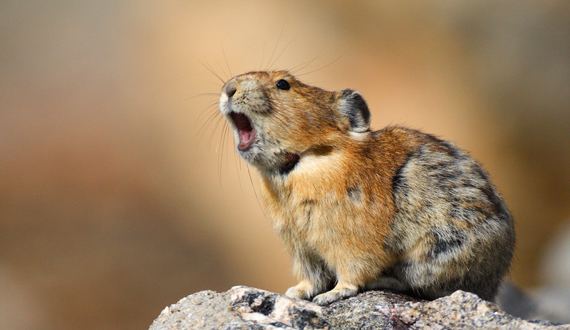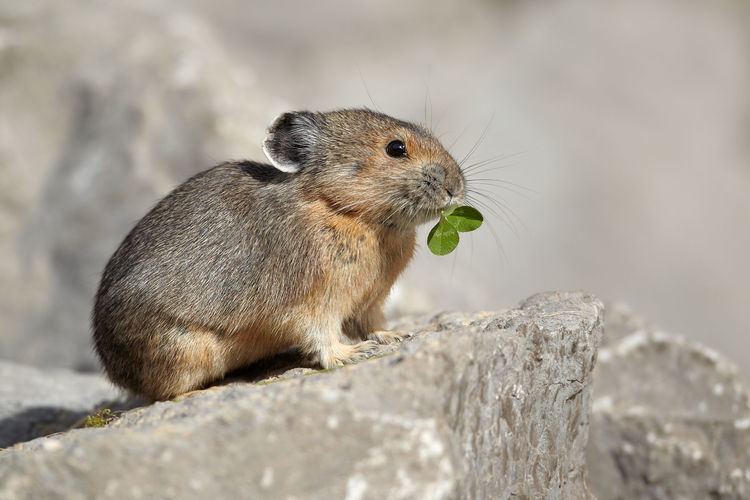Order Lagomorpha Higher classification Ochotonidae | Scientific name Ochotona Rank Genus | |
 | ||
Family OchotonidaeThomas, 1897 Lower classifications | ||
American pikas calling out cute animals in nature
A pika (/ˈpaɪkə/ PY-kə; archaically spelled pica) is a small mammal, with short limbs, very round body, rounded ears, and no external tail. Pikas look like a combination of a rabbit, guinea pig or vole. They live in mountainous countries in Asia, with two species also in North America. Most pikas prefer rocky slopes. The large-eared pika of the Himalayas and nearby mountains is one of the highest living mammals, found at heights of more than 6000 m. Pikas graze on a range of plants, mostly grasses, flowers and young stems. In the autumn, they pull hay, soft twigs and other stores of food into their burrows to eat during the long, cold winter. The name "pika" is used for any member of the Ochotonidae, a family within the order of lagomorphs, which also includes the Leporidae (rabbits and hares). One genus, Ochotona, is recognised within the family, and it includes 30 species. It is also known as the "whistling hare" due to its high-pitched alarm call when diving into its burrow. In the United States, the pika is colloquially called a "coney", a nonspecific term also used for rabbits, hares, and hyraxes. The name "pika" appears to be derived from the Tungus piika and the scientific name Ochotona is from the Mongolian word ogdoi which means pika.
Contents
- American pikas calling out cute animals in nature
- Collared pika prepares for winter wild alaska bbc
- Habitat
- Characteristics
- Activity
- Dialects
- Lifespan
- Species
- Extinct pikas
- References

Collared pika prepares for winter wild alaska bbc
Habitat

Pikas are native to cold climates, mostly in Asia, North America, and parts of Eastern Europe. Most species live on rocky mountain sides, where numerous crevices in which to shelter occur, although some pikas also construct crude burrows. A few burrowing species are native to open steppe land. In the mountains of Eurasia, pikas often share their burrows with snowfinches, which build their nests there.
Characteristics
Pikas are small mammals, with short limbs and rounded ears. They are about 15 to 23 centimetres (5.9 to 9.1 in) in body length and weigh between 120 and 350 grams (4.2 and 12.3 oz), depending on species. Like rabbits, after eating they initially produce soft green feces, which they eat again to take in further nutrition, before producing the final, solid, fecal pellets. Some pikas, such as the collared pika, have been known to store dead birds in their burrows, for food during winter.

These animals are herbivores, and feed on a wide variety of plant matter, including forbs, grasses, sedges, shrub twigs, moss, and lichen. As with other lagomorphs, pikas have gnawing incisors and no canines, although they have fewer molars than rabbits, giving them a dental formula of: 2.0.3.21.0.2.3
Rock-dwelling pikas have small litters of fewer than five young, while the burrowing species tend to give birth to more young, and to breed more frequently, possibly due to a greater availability of resources in their native habitats. The young are born after a gestation period of between 25 and 30 days.
Activity
Pikas are diurnal or crepuscular, with higher-elevation species generally being more active during the daytime. They show their peak activity just before the winter season. Pikas do not hibernate, so they generally spend time during the summer collecting and storing food they will eat over the winter. Each rock-dwelling pika stores its own "haypile" of dried vegetation, while burrowing species often share food stores with their burrow mates. Haying behavior is more prominent at higher elevations. Many of the vocalizations and social behaviors that pikas exhibit are related to haypile defense.
Eurasian pikas commonly live in family groups and share duties of gathering food and keeping watch. Some species are territorial. North American pikas (O. princeps and O. collaris) are asocial, leading solitary lives outside the breeding season.
Dialects
Pikas have distinct calls that vary in duration. The call can either be short and quick, a little longer and more drawn out, or they can be songs. The short calls are an example of geographic variation. The pikas determine the appropriate time to make short calls by listening for cues for sound localization. The calls are used as either a warning signal or as a way to attract the opposite sex. There are also different calls depending on the season. In the spring, the songs become more frequent due to the breeding season. In late summer, the vocalizations become short calls. Through various studies, the acoustic characteristics of the vocalizations can be a useful taxonomic tool.
Lifespan
The average lifespan in pikas is roughly seven years in the wild. In order to determine how old a pika is, one would have to count the adhesion lines on the periosteal bone on the lower jaw. The lifespan does not differ between the sexes.
Species
There are 30 species listed.
Extinct pikas
There are many known fossil forms of Ochotona described in the literature, from the Miocene epoch to the early Holocene (extinct species) and present (16.4-0 Ma). They lived in Europe, Asia, and North America. Note that some species listed below are common for Eurasia and North America (O. gromovi, O. tologoica, O. zazhigini and probably O. whartoni).
and others.
Paleontologists have also described multiple forms of pika not referred to specific species (Ochotona indet.) or not certainly identified (O. cf. antiqua, O. cf. cansus, O. cf. daurica, O. cf. eximia, O. cf. gromovi, O. cf. intermedia, O. cf. koslowi, O. cf. lagrelii, O. cf. nihewanica). The status of Ochotona (Proochotona) kirgisica and O. spelaeus is uncertain.
The "pusilla" group of pikas is characterized by archaic (plesiomorphic) cheek teeth and small size.
The North American species migrated from Eurasia. They invaded the New World twice:
Ochotona cf. whartoni and small pikas of the O. pusilla group are also known from Siberia. The extant, endemic North American species appeared in the Pleistocene. It has been suggested that the North American collared pika (O. collaris) and American pika (O. princeps) descended from the same ancestor as the steppe pika (O. pusilla).
The range of Ochotona was larger in the past, with both extinct and extant species inhabiting western Europe and eastern North America, areas that are currently free of pikas. Pleistocene fossils of the extant steppe pika Ochotona pusilla currently native to Asia have been found also in many countries of Europe from the United Kingdom to Russia and from Italy to Poland, and the Asiatic extant northern pika Ochotona hyperborea in one location in the middle Pleistocene United States.
Other genera of ochotonids (currently living only Ochotonidae) include except Ochotona (pika) extinct †Albertona, †Alloptox, †Amphilagus, †Australagomys, †Austrolagomys, †Bellatona, †Bellatonoides, †Bohlinotona, †Cuyamalagus, †Desmatolagus, †Eurolagus, †Gripholagomys, †Gymnesicolagus, †Hesperolagomys, †Heterolagus, †Kenyalagomys, †Lagopsis, †Marcuinomys, †Ochotonoides, †Ochotonoma, †Oklahomalagus, †Oreolagus, †Paludotona, †Piezodus, †Plicalagus, †Pliolagomys, †Prolagus, †Proochotona (syn. Ochotona), †Pseudobellatona, †Ptychoprolagus, †Russellagus, †Sinolagomys and †Titanomys. The earliest one is Desmatolagus (middle Eocene to Miocene, 42.5–14.8 Ma), usually included in Ochotonidae, sometimes in Leporidae or in neither ochotonid nor leporid stem-lagomorphs.
Ochotonids appeared in Asia between the late Eocene and the early Oligocene, and continued to develop along with increased distribution of C3 grasses in previously forest dominated areas under the "climatic optimum" from the late Oligocene to middle Miocene. They thrived in Eurasia, North America and even Africa. The peak of their diversity occurred during the period from the early Miocene to middle Miocene, most of them became extinct during the transition from the Miocene to Pliocene, what was accompanied by diversity increase in the leporids. It has been proposed, that this switch between ochotonids and larger leporids was caused by linked to global cooling expansion of C4 plants (particularly in the Poaceae) in the late Miocene, since extant pikas reveal a strong preference for C3 plants (Asteraceae, Rosaceae and Fabaceae, many of them C3). Replacement of large area of forest on the earth that time by open grassland first started probably in North America is called sometimes "nature's green revolution".
